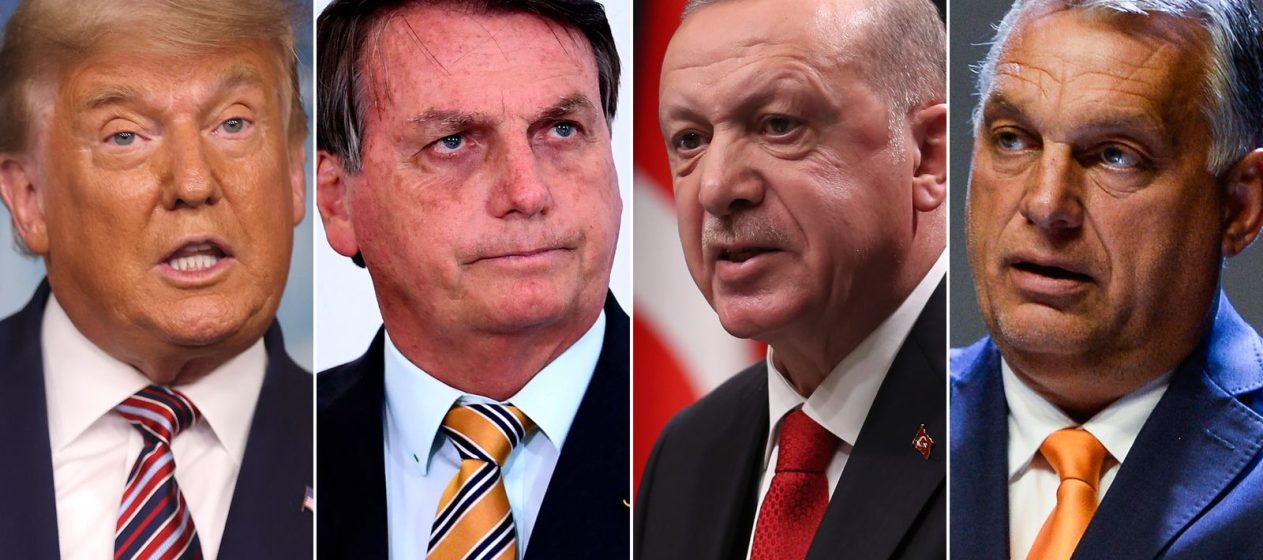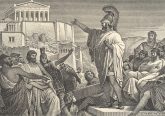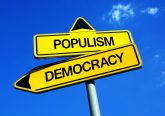The literature on populism in the 21st century often assumes that far-right leaders draw their support from voters who have lost out to globalisation. This is the case among low-skilled, white workers in Global North democracies, including the United States. But, there are also meaningful occurrences of backlash against the political establishment and liberal values in parts of the Global South that have clearly benefited from the post-Cold War trade openness.
For instance, two of the largest democracies in the developing world have been shaken by right-wing movements that came to power with the support of the winners of economic liberalisation. In Brazil, Jair Bolsonaro, a former army captain, won the presidency in 2018 with the support of agribusiness exporters and evangelical Christians and has supported further market opening. In India, the Hindu nationalist Prime Minister Narendra Modi is heading for a third consecutive term in 2024 on a promise of economic reform despite a U-turn on planned agricultural liberalisation in 2021 following mass protests by farmers in Delhi.
So how do we make sense of populism today? More than discontent with the redistributive effects of economic globalisation, the rise and consolidation of Bolsonaro, Modi, and their populist counterparts in the Global North—particularly Donald Trump in the United States—results from the mobilisation of specific ethnic, racial, and religious segments with the aim of changing longstanding narratives of national identity. The transformation of what it means to be Brazilian, Indian, and American, in turn, empowers certain social groups—and even certain economic sectors—over others.
This is the central argument of Shaping Nations and Markets: Identity Capital, Trade, and the Populist Rage (Routledge, 2023, p. 332), which I wrote based on my doctoral thesis in International Relations, which I defended in July 2014. While my doctoral thesis did not anticipate the populist wave that has rocked world politics since at least 2016 with the Brexit referendum and the Trump presidency, in my latest book, I built on the concept of identity capital to link earlier backlashes against patterns of globalisation during the negotiations of the only multilateral trade liberalisation round after the creation of the World Trade Organization (WTO) with the continuing rise of the far-right. As defined in the book, “identity capital is a sector’s contribution to the stability of a narrative of national identity. The larger the proportion of people working within a sector who are associated with the dominant narrative of national identity, the higher is the identity capital of the same sector” (p. 4). Populism, in turn, is a movement that consists of “…the redistribution of identity capital through the mobilisation of masses” (p. 12).
Identity capital matters for identifying those who hold more political power within a given sovereign state because a nation is more than its economy, political institutions, and organised interests. It also has a symbolic face that defines the boundaries of the social field. Drawing on sociological theory, particularly the contributions of Pierre Bourdieu, I define a field as “…a social space in which both individual and collective players are embedded and empowered according to different levels of capital. They are analogous to what in physics are defined as fields of force” (p. 7).
Linking national identity to power asymmetries
Identity capital reflects narratives of national identity, which in turn stem from cleavages based on social identities. In Brazil, low value-added sectors have a high proportion of non-whites. While Brazilians of African and/or indigenous descent have, on average, significantly lower incomes than whites, they have been symbolically empowered since the 1930s, when Brazil embraced narratives of national identity that praised non-European contributions to its formation.
Using secondary sources and regression analysis, I show that non-white identity capital is reflected in the overrepresentation of white minority states in the federal legislature. Although Brazil is a presidential republic, the president needs the support of representatives in the Chamber of Deputies (representing the people) and the Senate (representing the states) to govern the country.
Since the legislature is responsible for supporting the government and ratifying trade agreements, negotiators then would tend to anticipate the interests of those with more political power. Agribusiness and other low value-added sectors have a largely non-white workforce and demanded liberalisation in the Doha Round (DDA) against the protectionist interests of manufacturing, which was largely white and had lost economic power as globalisation gained momentum in the post-Cold War period.
Similarly, in India, the empowerment of liberalising and protectionist coalitions stems from identity capital. However, unlike what happened in Brazil during the DDA negotiations, the dominant Indian narrative of national identity as a secular state was aimed at controlling post-colonial religious tensions between Hindus and non-Hindus—particularly Muslims—rather than ethnic-racial disputes. Moreover, secularism in India was already under significant challenge from Hindu nationalists through the Bharatiya Janata Party (BJP), which is backed by middle and upper classes that have gained economic power through economic liberalisation since 1991.
Unlike Brazil, therefore, in India—which is a parliamentary federal republic where a prime minister needs the support of a majority in the lower house to run the country—, the identity capital of economic sectors depends on who controls the government. To the extent that sectors like information and communication technology services, which have benefited from globalisation, have an above-average proportion of Hindus, the BJP-led National Democratic Alliance (NDA) government in power at the start of the DDA talks has taken liberalising positions.
Evidence of the NDA’s commitment to further market opening can be found in its 2004 election manifesto, in which it pledged to reform India’s still regulation-heavy, smallholder-based agriculture and make it more competitive to boost food exports. Such a plan may have played a major role in the unexpected defeat of the BJP and its allies suffered at the hands of the Indian National Congress-led United Progressive Alliance (UPA), which reduced India’s bargaining scope in the WTO and adopted protectionist stances that eventually contributed to the collapse of the DDA negotiations during the Geneva Mini-Ministerial in July 2008.
As I show in the book through regression analysis, NDA MPs tended to come from states and union territories with a higher proportion of Hindus in their population. Conversely, during the first UPA government (2004-2009), no statistically significant correlation existed between religion and representation in the Parliament, which allowed the identity capital of economic sectors with a low share of Hindus to flourish. This is the case, for example, of small-scale agriculture and textiles.
Whiteness and the rise of protectionism in the United States
Is identity capital a force that shapes political power only in the developing world? Long before Trump managed to capture the Republican Party, there was evidence that white people were opposed to further trade liberalisation. Between 2003 and 2004, as Brazil and India successfully pushed the agriculture liberalisation card at the Doha negotiating table, the United States signed bilateral trade agreements with Australia, Chile, Morocco, and Singapore. Taken together, these agreements cover 92 per cent of the US exports classified at the eight-digit level of the Harmonised System (HS) (p. 204).
Ordered probit models indicate that representatives who voted in 2002 to give the president the trade promotion authority (known as fast track) needed to negotiate all of these agreements tended to be from congressional districts with a high share of whites. The results remain statistically significant even when relevant variables are added, including the share of skilled workers and manufacturing jobs. In the Senate, there is no meaningful correlation between the white share of the states’ population and the support for Fast Track. In all cases, Republican representatives favoured liberalisation over protection.
As in Brazil, the social cleavage that has structured the main narratives of national identity in the United States is race. As I explain in chapter 2 of Shaping Nations and Markets, “[t]hat is the case because although there have been major shifts in the American narrative of national identity since independence in 1776, they were all mainly structured around rigid divisions among ethnic groups based on rules of ancestry” (p. 27).
Since the height of the civil rights struggle in the 1960s, liberal forces in the United States have embraced multiculturalism as a parameter for defining what it means to be American. I then argue that “[i]n contrast to earlier emphasis on Whiteness only, multiculturalism confers symbolic power to individuals based on their belonging to an ethnic and/or racial community. Yet, as Whites remain most of the population, they tend to have more power under multiculturalism” (p. 27).
This is why whites in the United States have more identity capital than non-whites and are overrepresented in the House of Representatives because of gerrymandering. Given that protectionist economic sectors have a higher-than-average share of white workers, why has Washington continued to pursue trade liberalisation even after the DDA 2008 deadlock through initiatives like the ill-fated Trans-Pacific Partnership (TPP)?
The answer is simple: identity capital aside, the so-called conventional “Is”—interests, institutions, and ideas—still matter in shaping the national interest in trade negotiations. Yet by ignoring the protectionist demands of whites, both Democrats and Republicans have sown the seeds of far-right populism. In the American context, such a movement obstructs hyper-globalisation while reclaiming a narrative of national identity rooted in the White, Anglo-Saxon, Protestant (WASP) complex that underpins the United States as a sovereign nation.
Populism as the mobilisation and contestation of identity capital
Trump’s victory in the Electoral College in 2016 shocked the world. But it was clearly the culmination of longstanding tensions in the market and social spheres. Linear regression models show that the share of the vote for Trump per congressional district increased with the share of white and evangelical residents. More important, however, is the positive effect on the dependent variable of the interaction term between a vote against then-President Barack Obama’s fast track authority to negotiate the TPP in 2015 and the share of whites in the district.
Likewise, as Brazilian liberalisers were unable to translate the identity capital of their economic sectors into a pro-trade openness policies after the 2008 global financial crisis, when left-wing President Luiz Inacio Lula da Silva of the Workers’ Party (PT) adopted an economic interventionist mindset. His successor, Dilma Rousseff, did the same, further alienating agro-exporting constituencies already critical of the PT’s social policies amid the Chinese-led commodity boom of the early 21st century.
After Rousseff’s controversial impeachment in 2016 amid perceptions of widespread corruption, Brazil moved further to the right, then paving the way for the informal alliance of agribusiness, evangelicals, and military/police officers, the so-called beef, bible, and bullets (BBB) faction, which supported Bolsonaro in his successful presidential bid in 2018. Such a coalition instrumentalised identity capital in Brazil, by defending the country as a legacy of Christianity rather than the result of colonialism by European rulers against Native Americans and enslaved Africans.
Indeed, Bolsonaro’s rhetoric clearly downplayed non-European contributions to national formation. Moreover, his emphasis on Christian values pleased evangelical leaders and helped to mask his implicit white supremacist discourse. In contrast to what is happening in the United States, Brazil’s white population is already a numerical minority compared to non-whites. Therefore, any presidential candidate who ultimately adopts an overtly white-centric discourse in the Brazilian elections would risk facing a backlash. Moreover, by emphasising religious rhetoric, Bolsonaro could attract non-white support without alienating white voters.
The variables that explain the vote for Bolsonaro in Brazil and Trump in the US in specific constituencies— the share of whites and evangelicals—are the same in their failed re-election attempts in 2022 and 2020, respectively. This suggests that the American and Brazilian far-right movements, like Modi’s Hindu nationalism, have organic roots in society.
Yet, compared to its counterparts in Brazil and the United States, the BJP-led government has not been able to implement its economic agenda—particularly the promotion of agrarian reform. Despite the Covid-19 crisis, Brazilian agribusiness has thrived and achieved unprecedented growth during the Bolsonaro’s years. Trump has not made America great again, but with the trade war against China he has provided a snapshot of Washington’s supposed superiority over Beijing.
National identity and democracy: A never-ending struggle
Beyond the cases of Brazil, India, and the United States, identity capital can explain movements in trade closeness and openness before and after the DDA negotiations as well as other cases of populism in the 21st century.
Using regression analysis, I was able to generalise “…the argument across the left-right spectrum by showing that states mostly exposed to trade and with high ethnic fractionalization … tend to elect populist governments as measured by the Global Populism Database”. (p. 12). In contrast, the case of the Brexit referendum and the subsequent UK general election suggests that mobilisation of identity capital—Britishness against migrants—can occur at a particular point in time without generating a long-term populist movement.
This is the case because the Conservative Party either failed or did not want to reconstruct the narrative of national identity based on any meaningful social cleavage in the United Kingdom, such as whiteness and Christianity, which then led Britain to distance itself from populism as defined in the book. Possibly the fact that Brexit was perceived as having sorted out migration—the most divisive identity-related topic in contemporary United Kingdom—diminished the possibilities of exploring those identities for political purposes in an increasing ethnically diverse and non-religious country. Moreover, as Scottish separatism lost strength amidst SNP internal conflicts, incentives for reinforcing Conservative attachment to Englishness diminished.
Mexico and Canada are two further examples of the power of identity capital in trade negotiations. Mexican adhesion to the North American Free Trade Area (NAFTA) in 1992 represented the empowerment of mixed-race and white-dominated sectors representing the notion of raza cósmica (cosmic race) over the indigenous population, which was still dependent on subsistence agriculture swamped by economic liberalisation. In Canada, the internalisation of the provisions of the Comprehensive Economic and Trade Agreement (CETA) with the EU was mostly backed by MPs from constituencies where English is the dominant language at home—an expression of the dominant Anglo-centric features of Canadian multiculturalism.
In addition, the concept of identity capital can be useful in exploring why democracies may lose legitimacy. As I wrote in the book’s conclusion, “[t]he question therefore seems to scrutinize not only how democracies die …, but how all-inclusive nations and hence the narratives of national identity that get the closest to essentializing notions of civic citizenship die, particularly in democratic settings with ethnic diversity…” (p. 296).
To summarize, “[i]dentity capital has dictated the pace of globalisation and eventually its conversion into slowbalization” (p. 228). However, struggles over national identity are likely to continue in the years ahead, driving the making and unmaking of nations and markets around the world and not necessarily promoting protectionism along with ‘autocratisation’.







